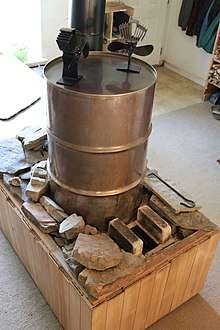Rocket mass heater
A rocket mass heater (RMH), also known as rocket stove mass heater, is a form of slow-release radiant heating system, designed to primarily heat people and secondary to warm areas in line of sight around it. Variations of RMH can also be extended for the functions of cooking, heating water, and producing warm air for distribution. [1].

Rocket mass heaters are developed from rocket stoves, type of wood-burning stoves, and masonry heaters. A primary design of a rocket mass heater consists of an insulated combustion chamber where fuel is burned with high efficiency at high temperature, and a large thermal mass in contact with the exhaust gases which absorbs most of the generated heat before the gases are released to the atmosphere.[2] According to various reports a rocket mass heater can reduce fuel consumption by 80 - 90% compared to "conventional" stoves.
In contrast to a conventional wood-burning stoves and fireplaces, in a rocket mass heater, combustion is close to complete. In a rocket mass heater, byproducts of combustion, such as smoke, soot, creosote compounds are sucked into the insulated tunnel of the unit where they further combust, releasing even more heat energy to drive the rocket process, unlike a normal fire where they are blown out the chimney.[3]
History
The word rocket in the name comes from a line of clean-burning cook stoves developed in the 1970s, using an insulated heat riser, to produce a clean and efficient fire. Mass refers to the mass of masonry where it stores heat.[1]
The first prototype was built in the 1980s. Although in some sense simply a variation on a masonry heater, most rocket mass heaters are distinct in producing immediate radiant heat (from the metal "burn" barrel), in being constructed of much cheaper materials (usually a cob mass, 55 gallon steel drum, and small brick firebox), and in requiring less robust a base to be constructed on, since a rocket mass heater's weight is distributed over a larger area. Moreover, masonry heaters have been used since pre-historic times and have evolved into various designs in Europe, Russia, and China. The key principle is the incorporation of a large thermal mass built of masonry which absorbs heat from exhausting combustion products directed in a sinuous path through channels embedded in the masonry.[4]
The rocket (cooking) stove was developed by the Aprovecho Institute, and described in 1982.[5] A rocket stove is a cooking appliance optimized to provide relatively high heat utilization and low emissions.
Different types of rocket mass heaters


There are several types of rocket mass heaters depending on how they are designed. In all designs, an internal insulated chimney called a "heat riser", produces an efficient high-temperature burn creating sufficient draft to push exhaust gases through the rest of the system. Flue gases are cooled to a relatively low temperature within the thermal store, approximately at 50 °C (122 °F). In some designs, steam within these gases condenses into liquid, releasing the associated latent heat of condensation which further increases the efficiency in the manner of a condensing (gas) boiler.
J-tube style
In the earliest and most popular form, wood is gravity-fed into a "J-shaped" combustion tube, from where the hot gases enter a well-insulated firebrick or ceramic refractory vertical secondary combustion chamber, the exhaust from which then passes along horizontal metal ducting embedded within a massive thermal store. The thermal store is large enough to retain heat for many hours and may form part of the structure of the building. They can be used with natural buildings and within permaculture designs; where they are normally self-built and are not recognized by all building codes which regulate the design and construction of heating systems within buildings.[3]
Cob style
A cob style rocket rocket mass heater uses Cob, which is a clay and sand mixture reinforced with straw, to insulate the drum and the pipes, taking in heat and slowly releasing it into the surrounding environment.[6] Because of the lower thermal conductivity, a mass consists of cob can absorb heat and retain it for longer period. This allows cob-style rocket mass heaters to warm a space for several days after the fire has stopped, thereby reducing amount of wood needed.[7]
Pebble style
Invented by Paul Wheaton in 2015, a pebble-style rocket mass heater uses pebbles and rocks to facilitate its thermal mass.[8] Compared to cob style rocket mass heaters, pebble style heaters weigh less, allowing them to be moved and modified easily. The lightweight design also makes them more suitable for installing in places that have a wooden floor. A pebble core also provides a different aesthetic look compared to Cob.[9]
Batch-box style
More recent alternate developments have instituted a batch-fed horizontal firebox called "batch box", which feeds into the vertical heat riser or secondary combustion chamber. Compared to a traditional J-style RMH, a batch-box style RMH can be loaded with more wood at once in a way that it will be run by itself for a longer period of time. The horizontal duct flow through the mass may be replaced by a massive "bell" of larger cross section where the hot gases slow and stratify and the cooled gases exit near the bottom as in some masonry heaters. These developments may be used in different combinations in specific instances. [10]
Components

Different types of rocket mass heaters are made with different components and different materials for specific purposes. All types of rocket mass heaters have three main components, named a wood feed, a heat riser and heat exchange mass. Depending on the design, a rocket mass heater can have different architecture within these components, and may also contain several other components designed for different purposes.[1]
Wood feed
The wood feed is the opening through which wood and air enter the system. In a J-tube design, the wood feed is a small and narrow opening that receives wood in a vertical orientation.[1] A wood feed is designed in a way that when wood sticks are inserted into the feed, only the bottom end of the sticks burn. Due to the direction of the airflow, the fire burns sideways, toward the combustion chamber and the heat riser. The horizontal direction of the fire prevents smoke from escaping the wood feed to the environment. As the bottom of the wood sticks burn, they get slowly pushed in to the feed.[11] The wood feed in a batch-box style rocket mass heaters allow more wood to be loaded at the same time.[10]
Heat riser
The heat riser is an insulated, vertical channel that draws flames upward and powers the rest of the firebox. The heat riser should be insulated to help hold the flames at high temperatures for a complete combustion.[12]. The low thermal conductivity of the insulation material allows temperature to build up within the heat riser to high temperatures. When the hot gasses reach the enclosing barrel, it gives off a significantly higher amount of heat, which cools the hot air to a relatively lower temperature. This flow causes a strong convective current within the heat riser, which creates a forward airflow which helps wood to burn sideways in the wood feed. The gasses that exit the heat riser are just Carbon dioxide and steam.[11]
Heat exchange mass
The thermal mass which encloses the exhaust duct and absorbs heat from the hot combustion gases is the interface that radiates heat to the environment. It can be made of cob, rocks, or pebbles. The thermal mass is often sculpted into a bench which can become an architectural feature of the home, radiating thermal energy into the space for several days after the wood fuel is exhausted.[7]
References
- Wisner, Erica; Wisner, Ernie. The Rocket Mass Heater Builder’s Guide. New Society Publishers. ISBN 978-0865718234. Retrieved 3 August 2020.
- Evans & Jackson, Rocket Mass Heaters, pp. 5, 20
- Meadows, Joel; Palmer, Dan (14 November 2016). "The fundamentals of Rocket Stoves". Permaculture Principles. Permaculture Principles. Retrieved 3 August 2020.
- Schumack, Mark (2016-01-25). "A computational model for a rocket mass heater". Applied Thermal Engineering. 93: 763–778. doi:10.1016/j.applthermaleng.2015.10.035. ISSN 1359-4311.
- Aprovecho, "Whole stoves"
- Apps, Rozie (20 February 2015). "Permaculture magazine". Permaculture magazine. Retrieved 6 August 2020.
- "8 things you need to know about rocket mass heaters". commonsensehome.com. Common Sense Home. Retrieved 6 August 2020.
- Wheaton, Paul. "pebble style rmh - in the fisher price house". permies.com. permies. Retrieved 6 August 2020.
- Wisner, Erica; Wisner, Ernie. "Rocket Mass Heaters: Build your own energy-efficient rocket mass heater stove". www.dirtcheapbuilder.com. DirtCheapBuilder. Retrieved 6 August 2020.
- van den Berg, Peter. "Results of the 8 batch box thingy at the Innovators Gathering (rocket mass heater forum at permies)". permies.com. Retrieved 4 August 2020.
- "rocket stove mass heater". richsoil.com. Richsoil. Retrieved 7 August 2020.
- Wisner, Erica; Wisner, Ernie. The Rocket Mass Heater Builder’s Guide. New Society Publishers. p. 8. ISBN 978-0865718234. Retrieved 7 August 2020.
External links
| Wikimedia Commons has media related to Rocket mass heater. |
- Ernie and Erica Wisner's site
- Rocket Stove Mass Heater Tour and How-To - includes video samples of 12 heaters and a 10-minute how-to